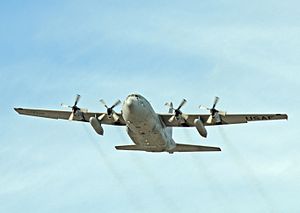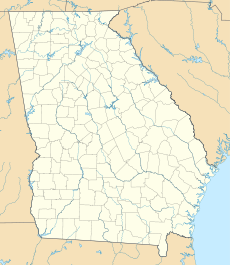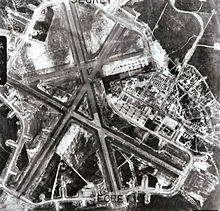- Savannah Air National Guard Base
-
Savannah Air National Guard Base Part of Georgia Air National Guard Located near: Savannah, Georgia
130H 165th AW Georgia ANG in flightCoordinates 32°07′39″N 081°12′7″W / 32.1275°N 81.20194°W Built 1939 In use 1942-Present Controlled by  United States Air Force
United States Air ForceGarrison 
165th Airlift WingAirfield information IATA: SAV – ICAO: KSAV – FAA LID: SAV Summary Elevation AMSL 50 ft / 15.2 m Website Runways Direction Length Surface ft m 10/28 9,351 2,850 Concrete 1/19 7,002 2,134 Concrete - See: Savannah/Hilton Head International Airport for civil airport information
Savannah Air National Guard Base is the home base of the Georgia Air National Guard 165th Airlift Wing.[1]
Contents
Overview
Savannah ANGB at Savannah/Hilton Head International Airport is home to the 165th Airlift Wing (165 AW), an Air Mobility Command (AMC)-gained unit of the Georgia Air National Guard, currently flying the C-130H Hercules tactical airlift aircraft. The wing consists of over 900 full-time Active Guard and Reserve (AGR), Air Reserve Technician (ART) and part-time "traditional" air national guardsmen, available for domestic operations as an Air National Guard unit or world-wide deployment in support of the U.S. Air Force and unified combatant commanders.[1]
Savannah ANGB also hosts the Combat Readiness Training Center (CRTC). Located at Savannah/Hilton Head International Airport/Savannah ANGB, the CRTC is one of four such training facilities in the nation. The CRTC provides airspace and ranges, aircraft parking, aircraft ground equipment (AGE), maintenance areas, training facilities, dormitories and other support functions for regular U.S. Air Force, Air Force Reserve Command, Air National Guard, U.S. Navy, Navy Reserve, U.S. Marine Corps and Marine Corps Reserve tactical jet aviation units.[1]
History
Origins
Savannah/Hilton Head International Airport was originally named Chatham Field and developed as a Works Progress Administration project at Cherokee Hill, one of the highest elevations in Chatham County, Georgia. In 1939 Congress had instituted a program to improve the nation's airport infrastructure in the interest of National Defense. If local governments provided the land, the Federal Government would fund construction of the airport. The City then approached the Civil Aeronautics Administration (CAA) about the possibility of building an airport at Cherokee Hill. The CAA accepted this proposal, informing the City that as much as $400,000 would be allocated for construction of three 4,000 ft (1,200 m) runways. The City purchased 600 acres (240 ha) at the CAA approved site seven miles (11 km) northwest of town center for $20,000.[2]
By the time the project got underway in 1941, the United States was on an unavoidable road to war and the Army Air Corps as well as the Navy took an interest in the strategically located coastal airport. The United States Navy, looking for a blimp base in the area, attempted to gain control of the airfield. The Air Corps, on the other hand, wanted the airfield for an auxiliary of Hunter Field, located 8 miles (13 km) south. The Interdepartmental Air Traffic Control Board, consisting of members of the Army, Navy and CAA to resolve conflicts such as this between the services, sided with the Air Corps. The Navy eventually built a blimp base at Brunswick, Georgia, 75 miles (121 km) to the south.[2]
With the Air Corps established already in the Savannah area at Hunter Field, work on Chatham proceeded at a slow pace. The construction project involved improving runways and airplane hangars, with three concrete runways, several taxiways and a large parking apron and a control tower being built. Several large hangars were also constructed. Buildings were ultimately utilitarian and quickly assembled. Most base buildings, not meant for long-term use, were constructed of temporary or semi-permanent materials. Although some hangars had steel frames and the occasional brick or tile brick building could be seen, most support buildings sat on concrete foundations but were of frame construction clad in little more than plywood and tarpaper. Chatham Army Airfield, named for its Georgia county location, finally activated on 19 September 1943, over two years since construction began.[2]
World War II
Initially a sub-base of Hunter Field, the Air Force intended Chatham AAF for use by Third Air Force, III Reconnaissance Command and the Army Air Forces Antisubmarine Command. In June 1943, the 100th Bombardment Squadron (Medium) was assigned to the airfield flying B-25 Mitchell bombers on antisubmarine patrols. However, in August, the antisubmarine patrol mission was transferred to the United States Navy.[2]
Two days after the base's activation, First Air Force took over command and made Chatham a sub-base of Jacksonville AAF. First Air Force used Chatham for B-24 operational training. Although Chatham had an adequate airfield, the cantonment area was deemed lacking with accommodations for only a reduced station complement and one tactical squadron. This presented a major problem since insufficient facilities existed to accommodate a B-24 group scheduled to arrive in the latter part of October. Hard work by base personnel provided necessary facilities when the 460th Bombardment Group, consisting of the 760th , 761st, 762nd, and the 763rd Bombardment Squadrons, arrived on 29 October 1943.[2]
After the 460th BG deployed to Fifteenth Air Force in Italy during January 1944, First Air Force changed Chatham's mission to replacement training. The 302d Bombardment Group (355th, 356th, 357th and 420th) flew B-24s as the Operational Training Units, training replacement B-24 aircrews. The 460th was replaced by squadrons of the 302d Bombardment Group (355th, 356th, 357th and 420th) flying B-24s as Operational Training Units, training replacement B-24 aircrews.[2]
On 1 May 1945, Chatham AAF was transferred from the First to the Third Air Force. Among the eight generals present for the ceremony was Major General Frank Hunter, commander of the First Air Force, a Savannah native, and the namesake of nearby Hunter Field. Among his acts that day, Hunter decorated eleven of Chatham's men.[2]
Chatham's new mission under Third Air Force was a training base for the B-29 Superfortress. By July, 29 B-29s were on hand. However, with the end of the war in 1945, Chatham AAF was no longer needed and it was placed on inactive status on 10 January 1946, with the 324 Army Air Force Base Unit (Standby) assuming caretaker duties over the facility.[2]
Cold War
The reconstituted Georgia Air National Guard stationed its 158th Fighter Squadron at Chatham Field on 13 October 1946, flying its P-47 Thunderbolts until 1949 when it moved to Hunter AFB to accommodate the active-duty Air Force.[2]
On 17 July 1947, the United States Air Force reactivated the Airfield. Chatham was assigned to Strategic Air Command, with the 380th Bombardment Group being assigned to jurisdiction of the base, and work was begun to modernize the airfield from its World War II wartime configuration into a permanent Air Force Base with modern facilities. Although Chatham had an adequate airfield for B-29 operations, the cantonment area was in poor condition. Constructed to last for five years, the buildings had reached the end of their life expectancy. In addition, the buildings' shortcomings also included outside latrines and potbellied stoves for heating.[2]
In January 1948, the base was renamed Chatham Air Force Base. On 1 November 1948 Boeing B-50 Superfortress aircraft were assigned to the base from the 307th Bombardment Group, with a mission being transition training of B-29 bomber crews to the new B-50. On 1 March 1949, Chatham was reassigned to Eighth Air Force and the 2d Bombardment Group was reassigned from Davis-Monthan AFB, Arizona to Chatham, with B-50s.[2]
The inadequacies of the support facilities at Chatham caused the Air Force to make the decision to leave Chatham and move to Hunter or leave Savannah. The facilities at Hunter AFB were built in the 1930s to permanent specifications and made Hunter much more desirable than Chatham. The City of Savannah interceded with the Air Force and offered to trade the larger Hunter Field, then a municipal airport, for the smaller Chatham AFB to keep SAC and the USAF in Savannah. This arrangement was agreed to and on 29 September 1950, the 2d Bomb Group moved to Hunter AFB and Chatham was turned over to the City of Savannah.[2]
In 1953, when the Air National Guard 158th Fighter Squadron returned from activation during the Korean War, it was based at Travis Field. This required the extension of Travis's east/west runway to 8,000 ft (2,400 m). for the Guard's F-84 Thunderjets.[2]
See also
References
 This article incorporates public domain material from websites or documents of the Air Force Historical Research Agency.
This article incorporates public domain material from websites or documents of the Air Force Historical Research Agency.- Shettle, M. L. (2005), Georgia's Army Airfields of World War II. ISBN 0-9643388-3-1
- Maurer, Maurer (1983). Air Force Combat Units Of World War II. Maxwell AFB, Alabama: Office of Air Force History. ISBN 0892010924.
- Mauer, Mauer (1969), Combat Squadrons of the Air Force, World War II, Air Force Historical Studies Office, Maxwell AFB, Alabama. ISBN 0892010975
- Ravenstein, Charles A. (1984). Air Force Combat Wings Lineage and Honors Histories 1947–1977. Maxwell AFB, Alabama: Office of Air Force History. ISBN 0912799129.
External links
 Strategic Air Command (SAC)
Strategic Air Command (SAC)Bases Active
(MAJCOM)CONUSAltus (AETC) • Andersen (PACAF) • Andrews (AMC) • Barksdale (ACC) • Beale (ACC) • Bolling (AFDW) • Cannon (AFSOC) • Columbus (AETC) • Davis-Monthan (ACC) • Dyess (ACC) • Eielson (PACAF) • Ellsworth (ACC) • Eglin (AFMC) • F. E. Warren (AFSPC) • Fairchild (AMC) • Forbes (ANG) • Grand Forks (AMC) • Grissom (AFRC) • Homestead (AFRC) • Lincoln (ANG) • Little Rock (AETC) • MacDill (AMC) • Malmstrom (AFSPC) • March (AFRC) • McChord (AMC) • McConnell (AMC) • McGuire (AMC) • Minot (ACC) • Mountain Home (ACC) • Nellis (ACC) • Offutt (ACC) • Patrick (AFSPC) • Pease (ANG) • Rickenbacker (ANG) • Robins (AFMC) • Seymour Johnson (ACC) • Sheppard (AETC) • Selfridge (ANG) • Travis (AMC) • Vandenburg (AFSPC) • Westover (AFRC) • Whiteman (ACC) • Wright-Patterson (AFMC)
OverseasRAF Alconbury (USAFE) • Diego Garcia (RAF) • Kadena (PACAF) • RAF Fairford (USAFE) • RAF Lakenheath (USAFE) • RAF Mildenhall (USAFE) • Thule (AFSPC)
InactiveCONUSAmarillo • Bergstrom • Biggs • Bong (unbuilt) • Calumet Air Force Base • Carswell • Castle • Chennault • Clinton-Sherman • Dow • Eaker • Glasgow • Grand Island (AAF) • Griffiss • Hunter • K. I. Sawyer • Kearney • Kincheloe • Larson • Loring • Lowry • Mather • McCoy • Plattsburgh • Presque Isle • Ramey • Shilling • Stead • Turner • Walker • Wurtsmith
OverseasRAF Bassingbourn • Ben Guerir • Boulhaut • RAF Brize Norton • RAF Bruntingthorpe • RAF Burtonwood • RAF Chelveston • RAF Greenham Common • Goose Bay • Ernest Harmon • RAF High Wycombe • RAF Upper Heyford • Torrejón • RAF Manston • Morón • Nouasseur • RAF Scampton • RAF Sculthorpe • Sidi Slimane • RAF South Ruislip • U-Tapao • RAF Waddington • RAF Woodbridge • RAF Wyton • Zaragoza

Units Air ForcesSecond Air Force • Eighth Air Force • Fifteenth Air Force • Sixteenth Air Force • Twentieth Air ForceDivisions AirStrategic
AerospaceStrategic Missile13thReconnaissance6th Strategic Reconnaissance • 26th Strategic Reconnaissance • 55th Strategic Reconnaissance • 544th Aerospace Reconnaissance TechnicalAerospaceAFCONMAJCOM3918th • 3920th • 3960th • 3970th • 3973d • 4026th • 4038th • 4039th • 4042d • 4043d • 4047th • 4080th • 4081st • 4082d • 4083d • 4123d • 4126th • 4128th • 4130th • 4133d • 4134th • 4135th • 4136th • 4137th • 4138th • 4141st • 4157th • 4158th • 4170th • 4228th • 4238th • 4239th • 4241st • 4245th • 4252nd • 4258th • 4321stSupportUSAAF
Groups
*=Initial Assigned
Unit Upon SAC's
ActivationBombardmentFighter27th (6/47) • 55th (2/47)Reconnaissance91st Strategic Reconnaissance (1/47)Major
weapon
systemsBombersCommand
& ControlFightersMissilesReconnaissanceTankersTransportCommanders Emblems Strategic Air Command Emblem Gallery (On Wikimedia Commons) USAAF Third Air Force in World War II
USAAF Third Air Force in World War IIAirfields Group Training Stations · Replacement Training Stations · Tactical Airfields
Units Commands II Air Support Command · III Air Support Command · III Bomber Command · III Fighter Command · III Reconnaissance Command · III Tactical Air CommandDivisions III Tactical Air DivisionWings 8th Fighter Wing · 9th Fighter Wing · 40th Bombardment WingGroups Air Commando 2nd Air Commando · 3rd Air CommandoBombardment 3rd Bombardment · 12th Bombardment · 17th Bombardment · 21st Bombardment · 29th Bombardment · 30th Bombardment Group · 38th Bombardment · 44th Bombardment · 46th Bombardment · 47th Bombardment · 85th Bombardment · 88th Bombardment · 90th Bombardment · 91st Bombardment · 92nd Bombardment · 93rd Bombardment · 94th Bombardment · 95th Bombardment · 97th Bombardment · 98th Bombardment · 99th Bombardment · 100th Bombardment · 309th Bombardment · 310th Bombardment · 312th Bombardment · 319th Bombardment · 320th Bombardment · 321st Bombardment · 322d Bombardment · 323d Bombardment · 335th Bombardment · 336th Bombardment · 340th Bombardment · 344th Bombardment · 345th Bombardment · 386th Bombardment · 387th Bombardment · 391st Bombardment · 394th Bombardment · 396th Bombardment · 397th Bombardment · 409th Bombardment · 410th Bombardment · 411th Bombardment · 416th Bombardment · 417th Bombardment · 418th Bombardment · 451st Bombardment · 454th Bombardment · 463rd Bombardment · 483rd Bombardment · 488th BombardmentFighter 20th Fighter · 31st Fighter · 49th Fighter · 50th Fighter · 53rd Fighter · 54th Fighter · 56th Fighter · 59th Fighter · 79th Fighter · 80th Fighter · 81st Fighter · 84th Fighter · 85th Fighter · 311th Fighter · 332nd Fighter · 337th Fighter · 338th Fighter · 339th Fighter · 361st Fighter · 369th Fighter · 372nd Fighter · 404th Fighter · 405th Fighter · 408th Fighter · 414th Fighter · 506th FighterFighter-Bomber 27th Fighter-Bomber · 48th Fighter-Bomber · 86th Fighter-Bomber · 406th Fighter-Bomber · 407th Fighter-BomberReconnaissance 2d Reconnaissance · 9th Reconnaissance · 10th Reconnaissance · 26th Reconnaissance · 65th Reconnaissance · 67th Reconnaissance · 68th Reconnaissance · 69th Reconnaissance · 70th Reconnaissance · 75th Reconnaissance · 77th Reconnaissance · 423d Reconnaissance · 424th Reconnaissance · 426th Reconnaissance USAAF First Air Force in World War II
USAAF First Air Force in World War IIAirfields · First Air Force Replacement Training Stations · First Air Force Tactical Airfields
Units Commands I Bomber Command (1941-42) · I Bomber Command (1943-1946) · I Fighter Command · I Ground Air Support Command · I Troop Carrier CommandWings 25th Antisubmarine · 50th Troop Carrier · 52d Troop Carrier · 53d Troop Carrier · 60th Troop Carrier · 61st Troop Carrier · Boston Fighter · New York Fighter · Norfolk Fighter · Philadelphia FighterGroups Bombardment 2d Bombardment · 13th Bombardment · 22d Bombardment · 34th Bombardment · 43d Bombardment · 45th Bombardment · 301st Bombardment · 302d Bombardment · 400th Bombardment · 402d Bombardment · 455th Bombardment · 459th Bombardment · 460th Bombardment · 471st BombardmentCombat Cargo 1st Combat Cargo · 2d Combat Cargo · 4th Combat CargoFighter 8th Fighter · 31st Fighter · 33d Fighter · 52d Fighter · 56th Fighter · 57th Fighter · 58th Fighter · 59th Fighter · 79th Fighter · 80th Fighter · 83d Fighter · 87th Fighter · 324th Fighter · 325th Fighter · 326th Fighter · 327th Fighter · 332d Fighter · 348th Fighter · 352d Fighter · 353d Fighter · 355th Fighter · 356th Fighter · 358th Fighter · 359th Fighter · 361st Fighter · 362d Fighter · 365th Fighter · 366th Fighter · 368th Fighter · 370th Fighter · 371st Fighter · 373d Fighter · 402d Fighter · 413th Fighter · 476th FighterReconnaissance 26th Reconnaissance · 73d ReconnaissanceTroop Carrier 10th Troop Carrier · 60th Troop Carrier · 61st Troop Carrier · 62d Troop Carrier · 63d Troop Carrier · 89th Troop Carrier · 313th Troop Carrier · 314th Troop Carrier · 315th Troop Carrier · 316th Troop Carrier · 317th Troop Carrier · 349th Troop Carrier · 375th Troop Carrier · 403d Troop Carrier · 433d Troop Carrier · 434th Troop Carrier · 435th Troop Carrier · 436th Troop Carrier · 437th Troop Carrier · 438th Troop Carrier · 439th Troop Carrier · 440th Troop Carrier · 441st Troop Carrier · 442d Troop CarrierOther 1st Search Attack · 477th CompositeCategories:- USAAF First Air Force Group Training Stations
- Airports established in 1941
- USAAF First Air Force Tactical Airfields
- USAAF Third Air Force Tactical Airfields
- USAAF Third Air Force Group Training Stations
- USAAF Third Air Force Replacement Training Stations
- Airfields of the United States Army Air Forces in Georgia (U.S. state)
- Facilities of the United States Air National Guard
Wikimedia Foundation. 2010.




